二、长寿时代的特征及形成
B. Characteristics and causes of the age of longevity
(一)长寿时代的特征
(a) Characteristics of the age of longevity
18世纪中期开始的工业革命打破了农业社会资源承载人口能力的限制,世界人口在那时开启了前所未有的大规模增长。基于对人口增长过程中出生率和死亡率变化的研究,1929年美国人口学家沃恩·汤普森(Warren Thompson)提出按人口增长模式可以将各国划分为三类。在此基础上,1945年弗兰克·诺特斯坦(Frank Notestein)进一步将人口增长模式归纳为潜在下降、转变增长、潜在高增长三个类别。此后对于人口增长模式的描述逐步发展形成了人口转变理论。当前普遍将人口转变分为四个阶段,即第一阶段是高出生率、高死亡率,人口规模不变或增长极其缓慢;第二阶段是高出生率、死亡率下降,人口快速增长;第三阶段是出生率下降、低死亡率,人口增速放缓;第四阶段是低出生率、低死亡率,人口规模趋于稳定。
The Industrial Revolution which broke out in the mid-18th century shattered the constraint of the capacity of agricultural social resources to support the population, and the world’s population began to grow, on an unprecedented, massive scale. Based on research into changes in birth rates and mortality in the population growth process, US demographer Warren Thompson in 1929 first proposed dividing countries into three types based on population growth patterns. On this basis, Frank Notestein in 1945 further summarised the population growth pattern into three categories: incipient decline, transformational growth, and high growth potential. Since then, the description of population growth patterns has gradually developed into the theory of demographic transition. Today, demographic transition is generally divided into four stages, namely a first stage characterised by its high birth rate and mortality, and a lack of change or extremely slow growth in population size; a second stage then introduces a high birth rate but a decline in mortality, and rapid population growth; a third stage then witnesses a decline in the birth rate, low mortality, and a slowing population growth rate; finally, a fourth stage has a low birth rate and mortality, and the population size tends to stabilise.
当前世界正在由人口转变的第三阶段快速转向第四阶段,但第四阶段以及之后会进入什么状态?我们在此提出长寿时代的概念,认为它将是人口转变后的新均衡。这一时代伴随着五大特征:低死亡率、低生育率、预期寿命持续提升、人口年龄结构趋向柱状、平台期老龄人口占比超越1/4。
The world is currently rapidly shifting from the third stage of the demographic transition to the fourth stage, but what state will we enter in this fourth stage and thereafter? Here, we would like to propose the concept of an age of longevity, and believe that this will form a new steady state following the demographic transition. This era will bring with it five major characteristics: low mortality, low fertility, continuously increasing life expectancy, a population age structure tending toward a pillar shape, and an ageing population segment which exceeds 1/4 of the total during the plateau period.
1.死亡率下降至低水平
1. Decline in mortality to low levels
19世纪人类的死亡率开始显著下降。当时生活水平提高、营养改善是决定性的因素。工业革命带来社会生产力水平大幅提升,使人们逐步摆脱了饥饿的困扰,增强了抵御疾病的能力。英国和法国的预期寿命分别从1750年的37岁和26岁增至1900年的48岁和46岁。英国学者托马斯·麦基翁(Thomas McKeown)提出19世纪英国死亡率下降是由于经济和生活条件的改善,其中最重要的是饮食的改善(McKeown,1962)。美国学者罗伯特·福格尔(Robert Fogel)也提出人们对周围环境的控制和创造技术革新的能力相互促进推动了死亡率的不断降低(Fogel,2004)。
The 19th century saw the start of a marked decline in human mortality, which was mainly driven by improved living standards and nutrition. The Industrial Revolution brought about substantial increases in social productivity, gradually freeing people from hunger, and strengthening their resistance to disease. Between 1750 and 1900, life expectancy in the United Kingdom and France rose from 37 years and 26 years to 48 years and 46 years respectively. British scholar Thomas McKeown pointed out that the drop in mortality in the UK in the 19th century was attributable to improvements in economic and living conditions, the most important of which was the improvement in diet (McKeown, 1962). US scholar Robert Fogel also proposed that people’s control over their environment and the ability to create technological innovation mutually promoted the continuous decline in mortality (Fogel, 2004).
公共卫生条件的改善对死亡率的下降同样扮演着重要的作用,尤其是对传染性疾病的控制。以美国为例,由于通过水和空气传播的传染性疾病得到了有效控制,1900年至1940年美国整体死亡率下降了40%,预期寿命从47岁提升至63岁,原来在城市生活死亡率更高的问题也在这一时期消失了。研究发现净水过滤和氯化系统的广泛应用在其中发挥了巨大的作用,为美国带来了这一史无前例、最为快速的死亡率下降(Cutler,2005)。此外,20世纪40年代抗生素类药物的使用进一步降低了传染病的病死率。例如,根据美国疾控中心数据显示,在此期间肺结核的死亡率一下从1945年的39.9/10万降到了1955年的9.1/10万。
The improvement in public health conditions played a similarly significant role in the decline in mortality, particularly with regard to the control of communicable diseases. If we take the US as an example, the effective control of air- and water-borne communicable diseases brought about a 40% reduction in overall US mortality between 1900 and 1940, an increase in life expectancy from 47 years to 63 years, and the phenomenon that mortality used to be higher in urban areas also disappeared at this time. Studies have shown that the widespread use of clean water filtering and chlorination systems played a huge role in this, bringing a historically unprecedented, rapid drop in mortality to the USA (Cutler, 2005). Furthermore, the introduction of antibiotic drugs in the 1940s further reduced mortality from infectious diseases. For example, US Centers for Disease Control and Prevention data shows that the death rate from tuberculosis during this period dropped from 399 per million in 1945 to 91 per million in 1955.
到20世纪下半叶,医疗和技术进步与死亡率下降的关系越来越密切。有研究指出美国20世纪50年代以来死亡率下降更多是得益于医疗进步带来的心脏病、中风等心血管疾病死亡率的降低。1950年至2016年美国预期寿命提升了11岁,其中一半以上的增长与65岁及以上人群生存率提升有关(Catillon et al.,2018)。此外,欧美发达国家在公共卫生方面的知识和现代医药技术向发展中国家的传播推动了全球死亡率的快速下降。1960~2000年期间公共卫生基础设施、免疫接种、疾病专项防治等成为带动发展中国家死亡率下降的重要因素,而收入和营养改善的影响已不像欧美发达国家早期所经历的那样显著(Soares,2007)。
During the latter half of the 20th century, the relationship between medical and technological progress and declining mortality became ever closer. Studies have shown that since the 1950s, the drop in mortality in the United States has been predominantly due to a decline in mortality thanks to medical progress in the treatment of cardiovascular diseases such as heart disease and stroke, inter alia. Between 1950 and 2016, life expectancy in the United States increased by 11 years, and more than half of this increase was related to the increased rate of survival in people 65 years and above (Catillon et al., 2018). In addition, awareness of public health in the developed nations of Europe and the Americas and the spread of modern medical technology to developing nations has driven a rapid decline in mortality worldwide. During the period from 1960-2000, public health infrastructure, immunisations, disease prevention and other measures have become major factors driving the drop in mortality in developing countries, although the impact of improvements in income and nutrition is no longer as significant as those previously experienced by the developed nations of Europe and the Americas (Soares, 2007).
新中国成立后,政府对卫生健康领域非常重视,并取得了巨大的成就,实现了死亡率的快速下降。20世纪50年代初期发起的全民卫生运动极大地改善了中国公共卫生状况,显著提升了对传染病的防治能力。《中国妇幼健康事业发展报告(2019)》显示,与解放前相比,到2018年中国孕产妇死亡率从1500/10万下降到18.3/10万,婴儿死亡率从200‰下降到6.1‰,平均预期寿命从35岁提升至77岁(见图1)。

Following the founding of the People’s Republic of China, the government attached great importance to hygiene and health, and has achieved tremendous results, bringing about a rapid reduction in mortality. The National Health Campaign, launched in the early 1950s, brought about a great improvement in China’s public health conditions, and significantly improved its ability to prevent and control infectious diseases. The China Maternal and Child Health Development Report (2019) shows that, when compared to the pre-1949 era, China’s maternal mortality rate dropped from 15 per thousand to 0.183 per thousand in 2018, while infant mortality dropped from 200 per thousand to 6.1 per thousand , and average life expectancy rose from 35 years to 77 years (see Figure 1).
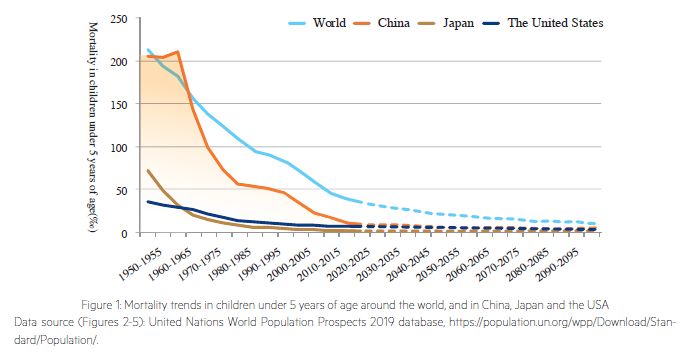
2.生育率下降至低水平
2. Decline in fertility to low levels
在农业社会,人是最重要的经济资源,孩子是生活保障和劳动力的来源,因此在高死亡率的生存环境下,高生育率是维持社会发展的需要。而工业革命的到来加速了城市化的进程,在这一过程中,女性的地位得到了根本性的提升,生育意愿也因此发生了改变。
In agricultural society, people are the most important economic resource, and children are a source of social security and labour. This means that, in an environment with a high mortality rate, a high fertility rate is necessary to ensure social development. However, the onset of the Industrial Revolution accelerated the process of urbanisation. Part of this process saw a fundamental improvement in the status of women, and this in turn brought about changes in their desire to reproduce.
首先,儿童死亡率的显著降低使人们对生育孩子数量的意愿产生了变化。孩子的质量与父母在时间和金钱上的投入相关,夫妻在潜在生育孩子的供给量和需求量上需要寻求一个平衡(Becker,1960)。其次,女性受教育水平的不断提升,增强了女性社会和工作参与的能力,改变了女性对生育的态度,在一定程度上也相应推迟了结婚和生育年龄。此外,对有效避孕知识的掌握和避孕工具的普及使两性行为与生育实现了分离。随着20世纪60年代廉价、便捷的避孕药在美欧及此后在全球的快速普及,有效的避孕工具变得简单易得(保罗·莫兰,2019)。
First of all, the significant drop in child mortality brought about a change in people’s willingness to have children. The quality of a child is partially determined by the amount of time and money invested by the parents, and partners must find a supply and demand balance in terms of the children that they may potentially have (Becker, 1960). Secondly, the continuous increase in the standard of women’s education has also enhanced their ability to participate in society and work, and this has brought about changes in women’s attitudes towards childbearing. To a certain degree, it has also delayed the age at which they marry and have children. In addition, a grasp of knowledge about contraceptives as well as the popularisation of contraceptive tools has also separated sexual activity from childbearing. With the rapid, widespread use of cheap and convenient contraceptive pill in the US, Europe and worldwide since the 1960s, effective contraception has become easy to obtain (Paul Morland, 2019).
20世纪70年代开始,生育率走低成为全球性趋势。不仅是发达国家,随着低收入国家的发展,其生育率也随之降低。1950~2017年所有国家和地区的总和生育率都出现了不同程度的下降,全球总和生育率下降了49.4%,由4.7个活产婴儿降至2.4个(Murray et al.,2018)。另据联合国中等假设水平预测,全球生育率还将继续走低,到2050年每名妇女生育子女数将降至2.2个,到2100年降至1.9个。
Since the start of the 1970s, declining fertility has become a global trend. Developed nations have not been alone in this – as lower-income countries have developed, their fertility rates have also decreased. Between 1950 and 2017, there has been, to varying degrees, a decline in the total fertility rate in every single country and region. The global total fertility rate dropped by 49.4%, from 4.7 live births to 2.4 (Murray et al., 2018). In addition, according to United Nations medium variant assumption level forecasts, the global fertility rate will continue to decline: the number of children per woman will drop to 2.2 by 2050, and to 1.9 by 2100.
中国自20世纪70年代起经历了生育率的快速下降,到1980年总和生育率已经从6左右降至3以下,到20世纪90年代已降至替代水平以下。这其中生育政策的影响只是一方面,实际上社会、人口、经济的发展变化越来越成为影响生育率的主导因素(都阳,2005)。近年中国二胎政策开放并没有带来生育率的回升,从国际经验来看,一些低生育率国家鼓励生育的政策也是需要漫长的时间积累才可能看出成效(杨昕,2016)(见图2)。
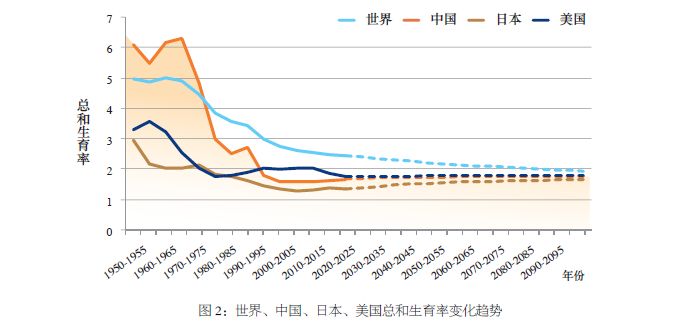
China has experienced a rapid drop in fertility since the 1970s. By 1980, total fertility rate had dropped from around 6 to below 3, and by the 1990s, had dropped further, to below the replacement level. However, the impact of fertility policy is only one aspect of this. In fact, social, demographic and economic developments have increasingly become the dominant factors impacting the fertility rate (Du Yang, 2005). In recent years, the launch of China's two-child policy has not brought about a resurgence in fertility. International experience has shown that policies to encourage childbirth in various low-fertility countries require plenty of time before the effects can be seen (Yang Xin, 2016) (see Figure 2).
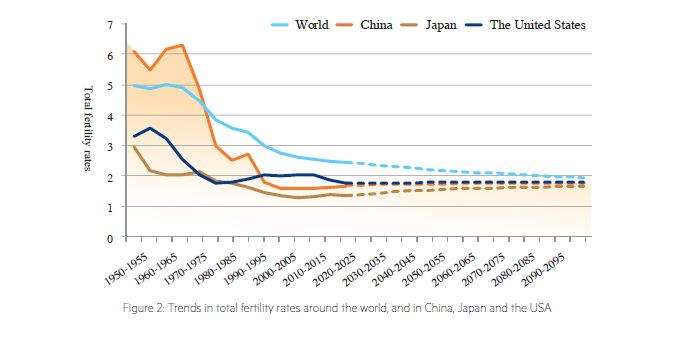
图2:世界、中国、日本、美国总和生育率变化趋势
Figure 2: Trends in total fertility rates around the world, and in China, Japan and the USA
3.预期寿命持续延长
3. Life expectancy continues to increase
新兴药物的不断创新、先进医疗技术的普及应用和进步使得心脑血管疾病、癌症、糖尿病、艾滋病等疾病逐渐从致死性的疾病杀手变成可控制的慢性疾病,人类的预期寿命得到持续延长,在过去半个多世纪里,主要发达国家都保持了每十年增长2~3岁的趋势。以癌症为例,研究数据显示,与1991年相比,2017年美国癌症死亡率已经下降了29%,其中2008年至2017年平均每年下降1.5%,2016年至2017年更是下降了2.2%,创历年新高(Siegel et al.,2020)。
Continuous innovation in emerging pharmaceuticals, the widespread application of – and progress in – advanced medical technologies have gradually transformed cardio- and cerebrovascular diseases, cancer, diabetes, AIDS and other previously fatal diseases into controllable, chronic diseases, leading to ever greater human life expectancy. Over the past half-century, the major developed countries have all maintained a growth trend of 2-3 years every decade. To take cancer as an example, research data shows that when compared to 1991, the US cancer mortality rate in 2017 had dropped by 29%, including an average annual decrease of 1.5% between 2008 and 2017. In 2016 and 2017, this rate dropped even further, by 2.2%, a record high (Siegel et al., 2020).
从全球来看,1950年以来人口预期寿命显著提升。1950~2017年全球男性预期寿命从48.1岁增至70.5岁,女性从52.9岁增至75.6岁(Dicker et al.,2018)。毫无疑问,人类的预期寿命还将保持稳步的增长,有预测研究指出到2040年全球男性和女性的预期寿命都将提升4.4年,届时日本、新加坡、西班牙、瑞士有望超过85岁,另有59个国家也将超过80岁(Foreman et al.,2018)。需要指出的是,近年来有研究发现美国和英国的人均预期寿命出现轻微下降,这背后是由青年人滥用药物、酗酒和自杀等社会问题引起,并不是老年人去世早了,也不能代表长期趋势(Ho and Hendi,2018)。
The life expectancy of the global population has increased significantly since 1950. Between 1950 and 2017, global life expectancy increased from 48.1 years to 70.5 years for males, and from 52.9 years to 75.6 years for females (Dicker et al., 2018). There is no doubt that human life expectancy will continue to see steady growth, and some predictive studies indicate that by 2040, global life expectancy for both males and females will increase by 4.4 years. By that time, the figure in Japan, Singapore, Spain, Switzerland is expected to exceed 85 years, while that for a further 59 countries will also exceed 80 years (Foreman et al., 2018). It should however be noted that in recent years, studies have found that average life expectancy in the US and UK has decreased slightly. This is due to social problems such as drug and alcohol abuse, suicide amongst young people, rather than premature deaths amongst the elderly. Equally, this does not represent a long-term trend (Ho and Hendi, 2018).
在中国,伴随着死亡率的快速下降,预期寿命也得到了大幅提升。20世纪60年代至20世纪70年代的20年间中国的预期寿命增长了22岁,之后以每10年增长约3岁的速度稳步提升,到2018年已达77岁。有研究预测到2040年中国预期寿命将达到81.9岁,也就是未来20年保持每十年增长约2.5岁的趋势(Foreman et al.,2018)。尽管联合国的预测相对保守,但是中国未来30年预期寿命仍将以平均每十年增长1.6~1.7岁的速度稳步提升(见图3)。
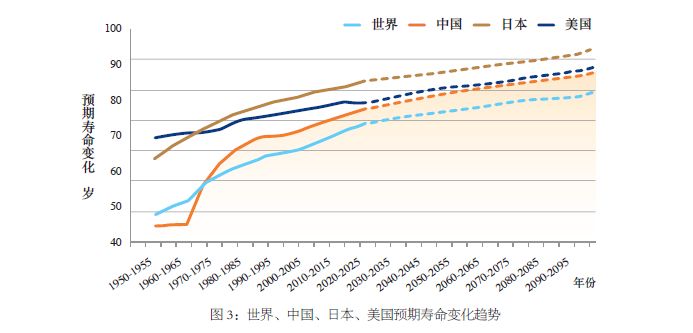
In China, hand in hand with a rapid decline in mortality, life expectancy has also improved significantly. In the two decades from the 1960s to the 1970s, life expectancy in China grew by 22 years, and has since then continued a rapid, stable growth rate of approximately 3 years every decade. By 2018, the figure stood at 77 years. Some studies predict that by 2040, life expectancy in China will reach 81.9 years, that is to say, the country will maintain a growth trend of 2.5 years every decade over the next 20 years (Foreman et al., 2018). The relatively conservative United Nations forecast is that life expectancy in China will still continue to increase steadily at an average rate of 1.6-1.7 years per decade over the next 30 years (see Figure 3).
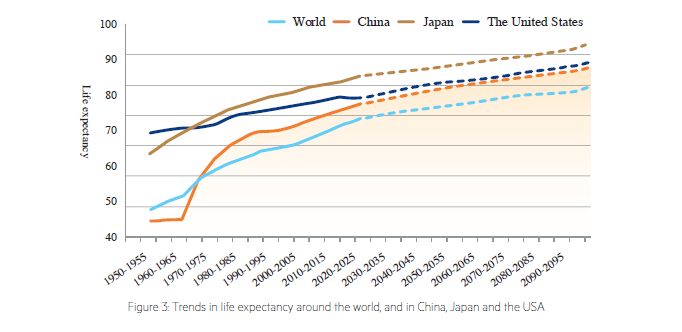
对于人类寿命是否存在增长的极限,目前尚无定论。有研究回顾1900年以来多国数据后提出人类的寿命受各种自然因素的限制是存在天花板的(Dong et al.,2016)。但是也有研究发现当年龄超过105岁之后,死亡风险水平基本上不再变化,死亡率不再随着年龄增大而上升(Barbi et al.,2018)。从经验角度看,经济、社会、医学的发展会不断推动人类寿命延长,人类的预期寿命可以持续地增长(Oeppen and Vaupel,2002;Vaupel and Kistowski,2005)。
Whether there is any limit to the human lifespan remains open to conjecture. Some studies which reviewed data from numerous countries from 1900 onward suggest that the human lifespan is limited by a number of natural factors, and that there is a ceiling (Dong et al., 2016). However, other studies have also found that at ages in excess of 105 years, the risk of death essentially does not change any further, and the mortality rate does not continue to increase with age (Barbi et al., 2018). From an empirical point of view, economic, social and medical developments will continue to drive the extension of the human lifespan, and human life expectancy can continue to rise (Oeppen and Vaupel, 2002; Vaupel and Kistowski, 2005).
4.人口年龄结构趋向“柱状”,老龄人口占比高峰平台期超越1/4
4. The population age structure has become “pillar-shaped”, with more than a quarter of the elderly population in a plateau period
在死亡率和生育率下降的双重作用下,世界人口增速放缓,全球的人口年龄结构在由传统的金字塔形态向柱状转变,即各年龄段人口占比向均等化发展,老龄人口与青少年人口数量均等化(Haub,2013)。从更为长期的角度看,由于生育率的持续下降,人口年龄结构还可能出现倒梯形。
Impacted by the dual effects of the decline in mortality and fertility, the world’s population growth rate has slowed, and the age structure of the global population has shifted from a traditional pyramid shape to a pillar shape, that is, where the proportions of the population for all age segments develop at the same pace, and the numbers for the elderly and young populations are equal (Haub, 2013). From a longer-term perspective, a continued decline in fertility may even mean that the population age structure takes on an inverted trapezoid shape.
联合国数据显示,1960~2020年,全球0~14岁少儿人口占比不断下降,由37.2%降至25.4%;65岁及以上老龄人口占比持续上升,由5.0%增至9.3%,并且预计在50年后二者将趋于均等。同时,在过去的60年间各国人口年龄结构转变的速度有所不同,例如美国在移民持续涌入的影响下,人口年龄中位数由29.7岁增至38.3岁,只增长了8.6岁;而日本受生育率快速下降且长期低迷的影响,人口年龄中位数由25.4岁跃升至48.4岁,增长达23.0岁。相比世界平均水平,中国人口年龄结构也发生了较快的转变。1960~2020年人口年龄中位数从21.3岁增至38.4岁,其中1960年至1990年只增加了3.6岁,而1990~2020年增长了13.6岁。
United Nations data shows that from 1960-2020, the proportion of the world’s child population aged 0-14 years declined continuously, from 37.2% to 25.4%. Conversely, the proportion of the population aged 65 years and above has continued to increase, from 5.0% to 9.3%, and it is estimated that 50 years later these two proportions will be close . At the same time, over the past 60 years, the rates of change in the population age structure for each country have varied widely. For example, in the US, under the impact of a continuous wave of immigration, the median age of the population increased from 29.7 years to 38.3 years, an increase of only 8.6 years. Meanwhile, in Japan, affected by a rapid decline in fertility and a long-term economic downturn, the median age of the population jumped from 25.4 years to 48.4 years, an increase of 23.0 years. Compared with the world average, the age structure of China’s population has also undergone rapid transformation. From 1960 to 2020, the median age of the population increased from 21.3 years to 38.4 years. From 1960 to 1990, the increase was a mere 3.6 years, whereas it grew by 13.6 years between 1990 and 2020.
经济学上将由于劳动年龄人口数量和占比增长快于其他年龄组人口所带来的经济增长称为人口红利(demographic dividend)(Bloom et al.,2003)。它通常发生在人口转型的第三阶段末,因为此时生育率发生快速下降使得受抚养的青幼年人口明显减少(Bloom and Williamson,1998)。新中国成立后的前20年死亡率大幅下降,而生育率继续保持高水平直至20世纪70年代初才开始明显降低,这使得改革开放后劳动年龄人口出现了爆发性增长,抚养比下降、劳动力供给充分带来的人口红利推动了中国的高速发展。然而,随着人口年龄结构的进一步转变,中国的人口红利在快速消退。国家统计局数据显示,中国的总抚养比在2010年已降至低点,2013年劳动年龄人口也已达到峰值。伴随着死亡率、生育率降至低水平并趋于稳定,预期寿命稳步提升,老龄人口占比增加,中国的人口年龄结构开始日渐趋于柱状(见图4)。
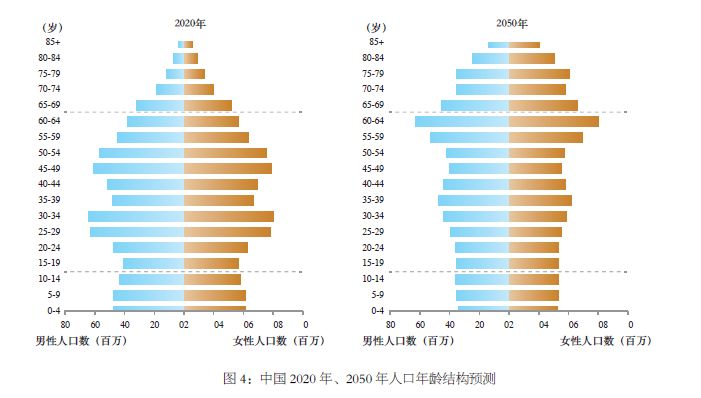
In economic terms, the economic growth generated because the number and proportion of the working age population grew faster than any other age group is called the demographic dividend (Bloom et al., 2003). This normally occurs at the end of the third stage of the demographic transition, as the rapid decline in fertility at this time significantly reduces youth dependent population (Bloom and Williamson, 1998). In the 20 years following the foundation of the People’s Republic of China, mortality dropped sharply, while fertility remained high until the early 1970s, after which it began to decline significantly. This led to the explosive growth of the working-age population following the start of the reform and opening up process, a drop in the dependency ratio, and the democratic dividend from China’s full labour force drove the country’s high-speed development. However, with the further transformation of the population age structure, China’s demographic dividend is fading rapidly. National Bureau of Statistics data shows that China's total dependency ratio had fallen to a low point by 2010, while the working-age population also peaked in 2013. With mortality and fertility at low levels and stabilising, and a steady increase in life expectancy, the proportion of the elderly population is increasing, and China's population age structure has started to take on an increasingly pillar-shaped appearance (see Figure 4).
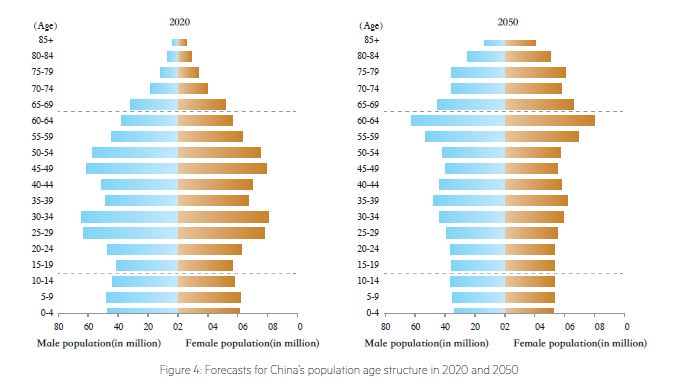
大多数经历人口转变第三阶段的国家都出现过或长或短的婴儿潮,之后生育率便急速下降。当婴儿潮老去,正好也是人口跨越第三阶段达到第四阶段的时候。低死亡率、寿命延长、生育率骤降造成了后期老龄人口的快速增长,经历过大幅婴儿潮的国家,老龄人口占比都会加速超越总人口的1/4,并且在达到峰值后,由于稳定的低生育率和预期寿命的持续延长,其比例会保持相对稳定。
Most countries which have undergone the three-stage demographic transition have experienced baby booms of varying lengths, after which the fertility rate has dropped sharply. The time that baby boomers get older is also precisely the time when the population crosses from the third stage into the fourth stage. Low mortality, extended lifespans and a sudden drop in the fertility rate lead to the rapid growth of the elderly population in the latter stage. In countries that have experienced large baby booms, the elderly proportion of the population accelerates to exceed one quarter of the total population, and after peaking, this proportion remains relatively stable because of stable, low fertility and continuous rising life expectancy.
与这个规律相符合,中国老龄人口数量及其占比正在进入快速增长期。国家统计局数据显示,2019年中国人口达到14亿,其中65岁及以上1.76亿,占比达到12.6%。2017年、2018年、2019年,65岁及以上人口分别新增828万、827万、945万。联合国预测,中国65岁及以上人口还将继续保持高位增长,直至2040年之后年均增幅才会降至500万人以下。到2057年65岁及以上人口与80岁及以上人口数量有望达到峰值,分别为4.0亿和1.3亿,占29.6%和9.8%。同时,从全球视角来看,中国是世界老龄人口数量最多的国家,2030年左右中国65岁及以上人口在全球老龄人口的占比将超过25%(见图5)。
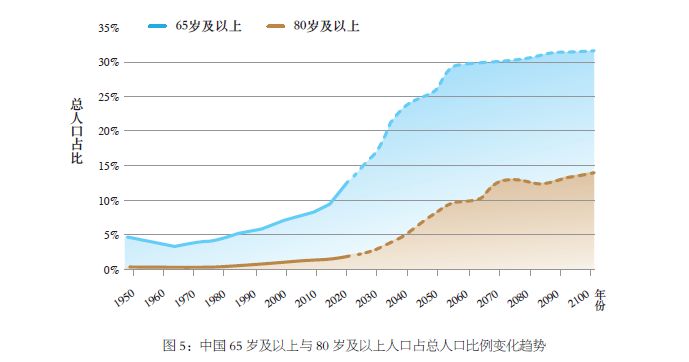
In line with this law, both the number and proportion of China’s elderly population are entering a period of rapid growth. National Bureau of Statistics data shows that China’s population reached 1.4 billion in 2019, of which 176 million were aged 65 years and above, making up 12.6% of the total. In 2017, 2018 and 2019, the population aged 65 years and above increased by 8.28 million, 8.27 million and 9.45 million respectively. The United Nations predicts that China’s population aged 65 years and above will continue to maintain a high rate of growth, and the annual rate of growth will not fall below 5 million before 2040. The population aged 65 years and above and the population 80 years and above are expected to peak by 2057, at 400 million and 130 million respectively, accounting for 29.6% and 9.8% of the total. At the same time, from a global perspective, China is the country with the largest number of elderly people in the world. By 2030 or so, China’s population aged 65 years and above will make up in excess of 25% of the world’s elderly population (see Figure 5).
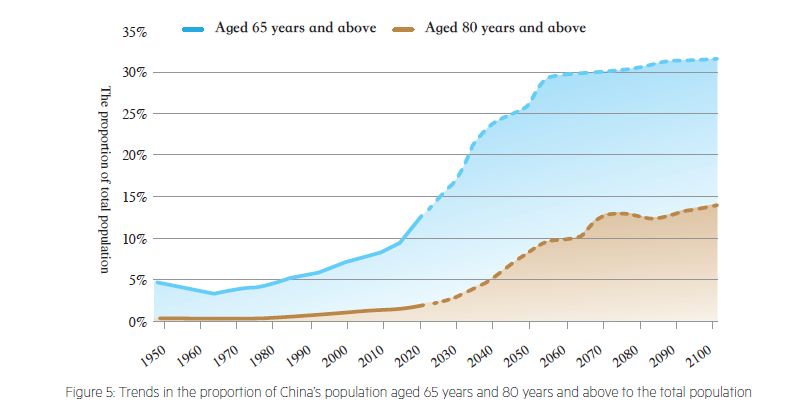
图5:中国65岁及以上与80岁及以上人口占总人口比例变化趋势
Figure 5: Trends in the proportion of China’s population aged 65 years and 80 years and above to the total population
(二)长寿时代与健康时代
(b) The age of longevity and age of health
在长寿时代,人类的预期寿命获得延长,同时也面临着与之前完全不同的健康挑战。健康成为更为迫切的需求,且这种需求将更加多样化和长期化,成为健康产业成长的强劲动力,健康时代随之来临。
In the age of longevity, life expectancy will rise, but at the same time, we will also face health challenges which are entirely different than before. Health becomes a more pressing need, and this need will become ever more diversified and long-term. This will become a powerful engine driving health industry growth, ushering in an age of health.
1.长寿时代疾病谱发生重大改变
1. Significant changes in the disease spectrum in the age of longevity
人类疾病类型的流行病学转变(Epidemiological Transition)(Omran,1977)与长寿时代同步来临。2002年召开的第二次世界老龄大会就已经指出,当时全球各区域都正处于流行病学转变的阶段,即从主要罹患传染性疾病和寄生虫病为主转向罹患慢性疾病和变性疾病为主(宋新明,2003)。
The epidemiological transition of human disease types (Omran, 1977) and the age of longevity arrive hand in hand. The Second World Assembly on Ageing held in 2002 highlighted the fact that at the time, all of the world’s regions were in a stage of epidemiological transition, that is to say, they were shifting from infectious and parasitic diseases as the main sources of infection to a situation where chronic and degenerative diseases prevail (Song Xinming, 2003).
华盛顿大学健康指标与评估研究所(IHME)2017年对195个国家和地区的研究表明:1990~2017年,新生儿疾病、肠道感染、呼吸道感染、结核病等传染性疾病导致的过早死亡人数下降,而缺血性心脏病、中风、慢阻肺等慢性病、老年性疾病则大幅上升,特别是缺血性心脏病成为全球首要致死原因(Roth et al.,2017)。(见表1)
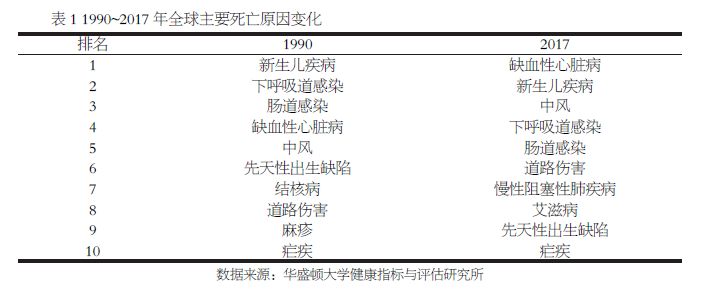
A 2017 study of 195 countries and regions by the Institute for Health Metrics and Evaluation (IHME) of the University of Washington shows that between 1990 and 2017, whereas the numbers of premature deaths from infectious diseases such as neonatal diseases, intestinal infections, respiratory tract infections and tuberculosis had dropped, chronic diseases such as ischemic heart disease, stroke and chronic obstructive pulmonary disease, as well as senile diseases increased significantly, and ischemic heart disease in particular had become the leading cause of death worldwide (Roth et al., 2017) (See Table 1).
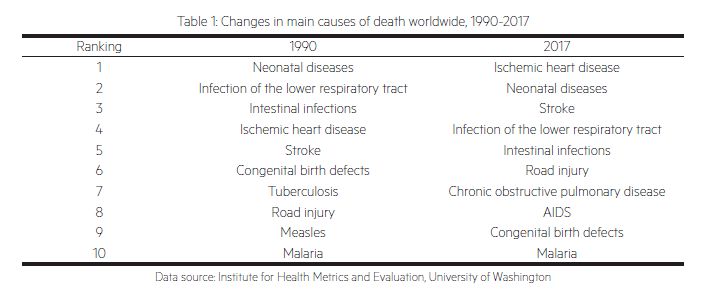
中国也正在面临同样的转变,中国1990~2017年致死和生命损失疾病谱前五名已经从传染性疾病、新生儿疾病等急性疾病、儿童期疾病转变为心脑血管疾病、肿瘤、退行性疾病等慢性病、老年性疾病(Zhou et al.,2019)。(见表2)

China is also facing the same transformation. Between 1990 and 2017, the top five causes of fatality in China changed from infectious, neonatal and other acute or childhood diseases to cardiovascular and cerebrovascular diseases, tumours, degenerative diseases and other chronic and senile diseases (Zhou et al., 2019) (See Table 2).

正是因为流行病学的转变,人类平均预期寿命延长的最大威胁已经从传染性疾病转移到衰老导致的退行性和人为疾病(如:道路伤害、意外死亡等),那些慢性退行性疾病未来随着人类生活方式变得更加健康、医疗技术创新加快、最终死亡年龄的延长,将在长寿时代与人类共存更长时间。
It is precisely because of this change in epidemiology that the greatest threat to the rise in average human life expectancy has shifted from infectious diseases to degenerative diseases caused by ageing and man-made diseases (e.g.: road injuries, accidental death, etc.). Chronic degenerative diseases of this kind will remain prevalent in humans for relatively longer periods of time in the age of longevity as human lifestyles become ever healthier, innovation in medical technology accelerates, and the final age of death is further extended.
各类非传染性慢性病正成为人类长寿健康损失的主要原因。根据世界卫生组织(WHO)的定义,伤残调整生命年(DALY)用来估量由于各种致命及非致命疾病所导致的健康损失,它等于寿命损失年数(YLL)与残疾生命年数(YLD)之和(Murray,1994)②。使用华盛顿大学健康指标与评估研究所数据计算的结果表明:从1970年到2016年之间,传染病以及营养不良所导致的健康损失下降了40.1%,与之对应的各种非传染性慢性病所导致的健康损失却整体增加了36.6%,其中心血管疾病增长了32.4%、神经系统疾病增长了59.4%;同期全球范围内80岁以上人口贡献的健康损失增长了98%(Wang et al.,2017)。同篇数据显示,老龄人口的增加给中国带来的健康损失情况比全球平均水平更为严峻。
Various types of non-communicable, chronic disease are becoming the main factor behind the loss of human longevity and health. Based on the World Health Organisation (WHO) definition, the disability-adjusted life year (DALY) is used to estimate the health loss caused by various fatal and non-fatal diseases. It is equal to the sum of the years of lost life (YLL) and years lived with disability (YLD) (Murray, 1994) (2). Using the calculation results from the data from the University of Washington’s Institute for Health Metrics and Evaluation, we find that from 1970 to 2016, the loss of health caused by infectious diseases and malnutrition dropped by 40.1%, while conversely, the loss of health caused by various non-communicable chronic diseases increased by 36.6% overall, of which cardiovascular disease grew by 32.4%, and neurological diseases grew by 59.4%. Over the same period, the loss of health contributed by the population aged 80 years and above grew by 98% (Wang et al., 2017). The same data shows that the loss of health to China caused by the elderly population is more severe than the global average.